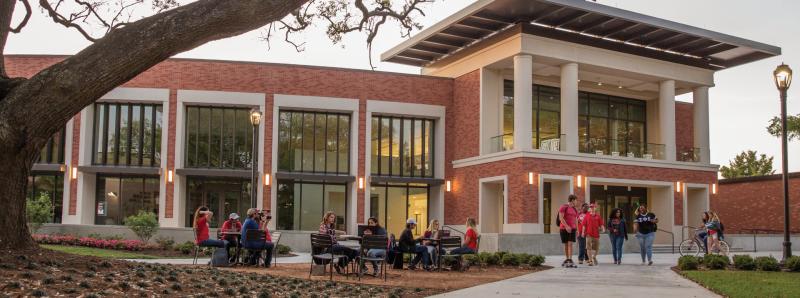Neches Federal Credit Union Arena at the Montagne Center, a multipurpose indoor arena and events centre at Lamar University in Beaumont, Texas (USA), has replaced its ageing audio system with an all-new high-end set-up powered by Powersoft’s cloud-based Unica amplifier platform.
Home to the Lamar Cardinals and Lamar Lady Cardinals basketball teams, both of which compete in the top-flight NCAA Division I, the 10,746-seat Neches Arena also hosts volleyball, gymnastics, wrestling, boxing and martial arts events, as well as concerts and other live entertainment. Lamar University, the venue’s owner/operator, additionally hires out the arena floor (which can be expanded to 19,965sq ft/1,855m²) for graduation ceremonies, proms, dances, banquets and conferences.
Kendall Bowman, acoustic engineer for Anthony James Partners (AJP), which designed and specified the new audio system, explains that the upgraded system needed to deliver on multiple fronts, being able to “meet the multifunctional needs of the arena, increase the intelligibility, and provide enough power to meet the demand of the space.” The AJP-designed sound system replaced an earlier set-up comprising just “one large full-range box and a few delay speakers”, which had fallen into disrepair and now failed to meet the needs of the space, he adds. “The university wanted to bring the system up to date with current technology and improve the experience for those attending events. They needed to have the designed system to be robust and provide many years of consistent use.”
The specified system, as installed and configured by Bluum Technology, comprises four Unica 8K8 (8,000W/eight-channel), two Quattrocanali 8804 DSP+D (9,600W/four-channel) and one Ottocanali 8K4 (8,000W/eight-channel) amplifier platforms, along with a Midas M32 console, four Shure ULXD wireless microphones, a Q-SYS Core 110f processor, and Netgear M4250 switches. The Powersoft amplifiers power an all-Fulcrum speaker set-up consisting of 20 FH15 and 24 CX826 speakers and four Sub218L subwoofers.
The speakers utilise the DSP built into the Powersoft amplifiers, with additional processing and control provided by the Q-SYS Core, installed by Bluum in a rack under the basketball court bleachers (seating). The pull-out bleachers also house the Netgear switches, a touch panel and audio connection points. A redundant Dante AV-over-IP network transports the sound to the control room over fibre cable, reveals Trey Bracamonte-Harrell, lead integration tech for Bluum.
Featuring high power density, top-shelf sound quality and class-leading efficiency, Unica is designed to meet the requirements of a wide range of installations in a single amplifier platform. Its extensive power options, functionalities and networking capabilities make it ideal for all applications, from background music to performance venues – essential for a venue like Neches Arena, where the sound system will be responsible for everything from sport- and team-related audio and voiceovers to live and recorded music.

As in many retrofits of older venues (the Montagne Center was built in 1984), the design of the new sound system was constrained by the space available, with AJP having to work around the existing infrastructure – including the remnants of the old system – Bowman continues, outlining the challenges faced by his team and Bluum: “The old system had been repaired and updated many times, leaving behind traces of the old system, with many pieces of the system in several different locations. We wanted to make sure that the new system would be able to have permanent home and create a clean result with as few locations to house the equipment as possible. In the end, we were able to work with the university to find an appropriate location for the amplifiers and processing equipment, and while maintaining easy access for maintenance and monitoring.”
That appropriate location was a Middle Atlantic WRK rack, which houses the Powersoft amplifiers and networking equipment. This complements the under-bleacher rack (also a Middle Atlantic model) and a portable audiophile rack containing the console and microphones; elsewhere, AJP used the arena’s existing steel grid to find appropriate hang points for the speakers (while still allowing space for the grid to be used for rigging visiting events).
In addition to impressing with its amplifier platforms, Powersoft won over Bowman with the support offered by its US team, who were an “amazing resource for this project”, he comments: “They helped make sure the amplifiers were the correct match for the system and offered suggestions to create the best power possible. In addition, they provided some needed support on the control programming side, which allowed the amplifiers to be managed through the Q-SYS platform. This provided great feedback on the touch panel in regards to monitoring system health and allowing zone control of the system.”
Bowman describes the final result as a “great success”, with Lamar University “very happy with the overall result” delivered by AJP, Bluum and Powersoft. “They are now able to provide the experience they intended for their attendees for many years to come,” he says. “They still call once in a while if they need help sorting out signal flow for a specific game,” adds Bracamonte-Harrell.
“It was exciting to be able to design a system that brought high intelligibility and audio quality to every seat in the arena,” concludes Bowman, “and give those attending events a much-needed improvement.”